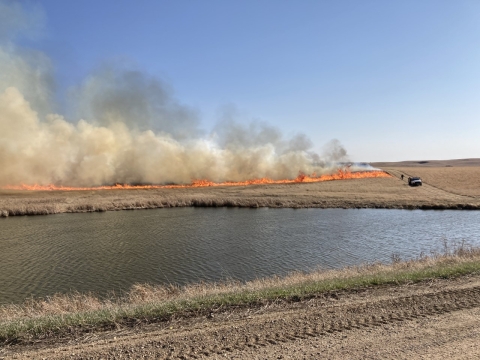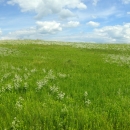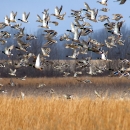What We Do
Wildlife conservation is at the heart of the National Wildlife Refuge System. It drives everything on U.S. Fish and Wildlife Service lands and waters. From the recreational activities offered, to the resource management tools used, Refuge System managers use the best conservation practices to ensure the survival of native wildlife species.
Audubon Wetland Management District administers management actions on multiple refuges, waterfowl production areas, and other conservation areas from a central office location by the U.S. Fish and Wildlife Service. These lands are grouped based on similar ecological region, such as a watershed or specific habitat type, and have a related purpose and management needs. A project leader oversees the general management of all refuge lands within these lands, and refuge managers are responsible for using habitat management tools to best manage the lands for wildlife. Supporting staff, composed of administrative, law enforcement, biological, fire, visitor services, and maintenance professionals, are centrally located and support all refuge lands within the Wetland Management District.
Management and Conservation
Waterfowl Production Areas have been purchased by the U.S. Fish and Wildlife Service (Service) with funds from the sale of Federal Duck Stamps. Established to protect and restore waterfowl habitat, nearly 95 percent of Waterfowl Production Areas in the United States are located in the Prairie Pothole Region of North and South Dakota, Minnesota, Iowa, and northeastern Montana. Approximately 98 cents of each Duck Stamp dollar is used to purchase habitat.
Wildlife dependent recreational activities are allowed on Waterfowl Production Areas, including hunting, fishing, trapping, wildlife observation, photography, environmental education, and interpretation.
Eight National Wildlife Refuges are located in the Audubon Wetland Management District. A portion of these refuges are owned in fee title by the Service and others are easement refuges. Easement refuges are private lands in which the Service has purchased and regulates water rights.
Prescribed Burning
Controlled burns are often called prescribed burns because wildlife managers write a careful prescription of the weather conditions, equipment, and people necessary to safely conduct a burn that will have the desired ecological effect. Fire is used to help wildlife and wildlife habitat by stimulating prairie plant growth, increasing soil nutrients, and setting back the invading trees and other species not adapted to life on the prairie.
Prairie animals are also adapted to fire. Some go underground during the fire. Others simply fly or run away from the fire. Sometimes, birds lose their nests to fire, but native grassland species have an adaptation for this: they quickly respond by building a new nest and laying a new clutch of eggs. While there is some short-term harm to some nests or animals, these same species depend on fire for their survival, since many prairie plants and animals cannot survive long, once shrubs or trees take over their grassland habitat.
Rotational Livestock Grazing
Wildlife managers work together with local ranchers to mimic natural disturbances that were once caused by large herds of free-ranging bison and elk on the prairie. Through livestock grazing, invasive cool-season grasses and other invasive plants can be stressed, which favors native grasses and forbs such as western wheatgrass, green needlegrass, blue grama, little bluestem, purple coneflowers, goldenrods and low growing shrubs. Grazing can greatly influence the structure and diversity of grassland communities.
Water Level Management
Water levels on wetlands are carefully monitored and controlled with water control structures to foster desired plant growth. Management objectives focus on providing habitat and food for nesting, rearing, and migrating birds. An especially important plant, sago pondweed, provides shoots and tubers as a food source for birds. The invertebrates these plants support are also an important food source for waterfowl, shorebirds, and many other wildlife species, especially when nurturing broods.
Invasive Species Control
Invasive species are plants and animals that are not native to an area, and can cause economic or environmental harm. One of the largest threats to public lands in the United States, next to habitat loss, is the invasion of invasive plant and animal species. If left unchecked, invasive species invasive species
An invasive species is any plant or animal that has spread or been introduced into a new area where they are, or could, cause harm to the environment, economy, or human, animal, or plant health. Their unwelcome presence can destroy ecosystems and cost millions of dollars.
Learn more about invasive species can alter habitat and water quality.
Wildlife managers use livestock grazing, burning, chemical application and insects to control invasive plants such as smooth brome grass, Kentucky bluegrass, Canada thistle, absinth wormwood, leafy spurge, Russian olive and Siberian elm trees.
Staff deploy a host of scientifically sound management tools to address biological challenges. These tools span active water management to wilderness character monitoring, all aimed at ensuring a balanced conservation approach to benefit both wildlife and people. At this field station, our conservation toolbox includes:
- Planning – Comprehensive Conservation Plan
- Compatibility Determinations
- Cultural Resources
- Education & Outreach
- Fire Management
- Grazing
- Invasive Species
- Inventory and Monitoring
- Law Enforcement
- Pesticide Management
- Recreation Management
- Species Research
- Water Management
Our Services
Audubon Wetland Management District headquarters, including an office and visitor center, is located at the Audubon National Wildlife Refuge near Coleharbor, North Dakota. The Waterfowl Production Areas in the Audubon Wetland Management District do not have facilities and amenities for visitors.
Local farmers and ranchers have the opportunity to help us accomplish our grassland management objectives on Wetland Management District lands. If you are interested in grazing livestock or harvesting hay, please contact a Wetland District Manager at (701) 442-5474 or audubon@fws.gov.
Our Projects and Research
Our National Wildlife Refuges are places for everyone to learn about and discover the outdoors. This opportunity is utilized by numerous local grad students from local universities and other government organizations over the years, researching a wide variety of wildlife and plant species on the refuge. If interested in performing a research project on refuge lands please contact: Audubon National Wildlife Refuge (audubon@fws.gov).
Law Enforcement
Law Enforcement
Law enforcement is essential to virtually every aspect of wildlife conservation. The Office of Law Enforcement contributes to Service efforts to manage ecosystems, save endangered species, conserve migratory birds, preserve wildlife habitat, restore fisheries, combat invasive species invasive species
An invasive species is any plant or animal that has spread or been introduced into a new area where they are, or could, cause harm to the environment, economy, or human, animal, or plant health. Their unwelcome presence can destroy ecosystems and cost millions of dollars.
Learn more about invasive species , and promote international wildlife conservation.
Service law enforcement focuses on potentially devastating threats to wildlife resource-illegal trade, unlawful commercial exploitation, habitat destruction, and environmental contaminants. The Office of Law Enforcement investigates wildlife crimes, regulates wildlife trade, helps Americans understand and obey wildlife protections laws, and works in partnership with international, state, and tribal counterparts to conserve wildlife resources. This work includes:
- Breaking up international and domestic smuggling rings that target imperiled animals.
- Preventing the unlawful commercial exploitation of protected U. S. species.
- Protecting wildlife from environmental hazards and safeguarding critical habitat for endangered species.
- Enforcing federal migratory game bird hunting regulations and working with states to protect other game species from illegal take and preserve legitimate hunting opportunities.
- Inspecting wildlife shipments to ensure compliance with laws and treaties and detect illegal trade.
- Working with international counterparts to combat illegal trafficking in protected species.
- Training other federal, state, tribal, and foreign law enforcement officers.
- Using forensic science to analyze evidence and solve wildlife crimes.
- Distributing information and outreach materials to increase public understanding of wildlife conservation and promote compliance with wildlife protection laws.
If you have any questions about Law Enforcement or Rules & Regulations in the Wetland Management District, please feel free to call our Law Enforcement at 701/442-5474.
Laws and Regulations
Wildlife dependent recreational activities are allowed on Waterfowl Production Areas. These activities include hunting, fishing, and trapping in accordance with State regulations. Visitors can also enjoy wildlife observation and photography on these lands.




